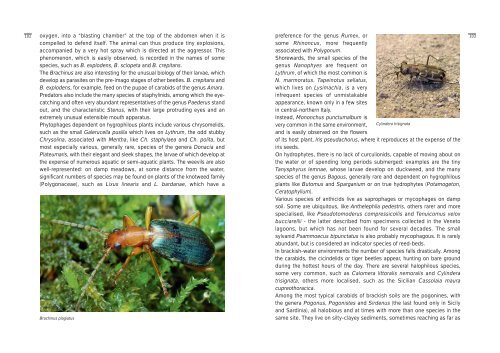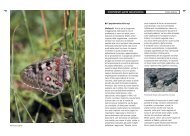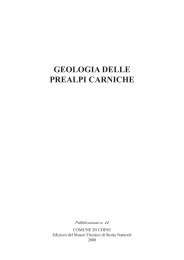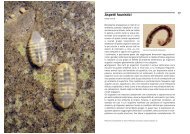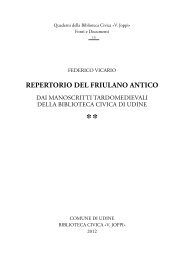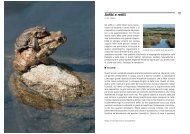Terrestrial invertebrates - Udine Cultura
Terrestrial invertebrates - Udine Cultura
Terrestrial invertebrates - Udine Cultura
Create successful ePaper yourself
Turn your PDF publications into a flip-book with our unique Google optimized e-Paper software.
102<br />
oxygen, into a “blasting chamber” at the top of the abdomen when it is<br />
compelled to defend itself. The animal can thus produce tiny explosions,<br />
accompanied by a very hot spray which is directed at the aggressor. This<br />
phenomenon, which is easily observed, is recorded in the names of some<br />
species, such as B. explodens, B. sclopeta and B. crepitans.<br />
The Brachinus are also interesting for the unusual biology of their larvae, which<br />
develop as parasites on the pre-imago stages of other beetles. B. crepitans and<br />
B. explodens, for example, feed on the pupae of carabids of the genus Amara.<br />
Predators also include the many species of staphylinids, among which the eyecatching<br />
and often very abundant representatives of the genus Paederus stand<br />
out, and the characteristic Stenus, with their large protruding eyes and an<br />
extremely unusual extensible mouth apparatus.<br />
Phytophages dependent on hygrophilous plants include various chrysomelids,<br />
such as the small Galerucella pusilla which lives on Lythrum, the odd stubby<br />
Chrysolina, associated with Mentha, like Ch. staphylaea and Ch. polita, but<br />
most especially various, generally rare, species of the genera Donacia and<br />
Plateumaris, with their elegant and sleek shapes, the larvae of which develop at<br />
the expense of numerous aquatic or semi-aquatic plants. The weevils are also<br />
well-represented: on damp meadows, at some distance from the water,<br />
significant numbers of species may be found on plants of the knotweed family<br />
(Polygonaceae), such as Lixus linearis and L. bardanae, which have a<br />
Brachinus plagiatus<br />
preference for the genus Rumex, or<br />
some Rhinoncus, more frequently<br />
associated with Polygonum.<br />
Shorewards, the small species of the<br />
genus Nanophyes are frequent on<br />
Lythrum, of which the most common is<br />
N. marmoratus. Tapeinotus sellatus,<br />
which lives on Lysimachia, is a very<br />
infrequent species of unmistakable<br />
appearance, known only in a few sites<br />
in central-northern Italy.<br />
Instead, Mononchus punctumalbum is<br />
very common in the same environment, Cylindera trisignata<br />
and is easily observed on the flowers<br />
of its host plant, Iris pseudachorus, where it reproduces at the expense of the<br />
iris seeds.<br />
On hydrophytes, there is no lack of curculionids, capable of moving about on<br />
the water or of spending long periods submerged: examples are the tiny<br />
Tanysphyrus lemnae, whose larvae develop on duckweed, and the many<br />
species of the genus Bagous, generally rare and dependent on hygrophilous<br />
plants like Butomus and Sparganium or on true hydrophytes (Potamogeton,<br />
Ceratophyllum).<br />
Various species of anthicids live as saprophages or mycophages on damp<br />
soil. Some are ubiquitous, like Anthelephila pedestris, others rarer and more<br />
specialised, like Pseudotomoderus compressicollis and Tenuicomus velox<br />
bucciarellii - the latter described from specimens collected in the Veneto<br />
lagoons, but which has not been found for several decades. The small<br />
sylvanid Psammoecus bipunctatus is also probably mycophagous. It is rarely<br />
abundant, but is considered an indicator species of reed-beds.<br />
In brackish-water environments the number of species falls drastically. Among<br />
the carabids, the cicindelids or tiger beetles appear, hunting on bare ground<br />
during the hottest hours of the day. There are several halophilous species,<br />
some very common, such as Calomera littoralis nemoralis and Cylindera<br />
trisignata, others more localised, such as the Sicilian Cassolaia maura<br />
cupreothoracica.<br />
Among the most typical carabids of brackish soils are the pogonines, with<br />
the genera Pogonus, Pogonistes and Sirdenus (the last found only in Sicily<br />
and Sardinia), all halobious and at times with more than one species in the<br />
same site. They live on silty-clayey sediments, sometimes reaching as far as<br />
103


